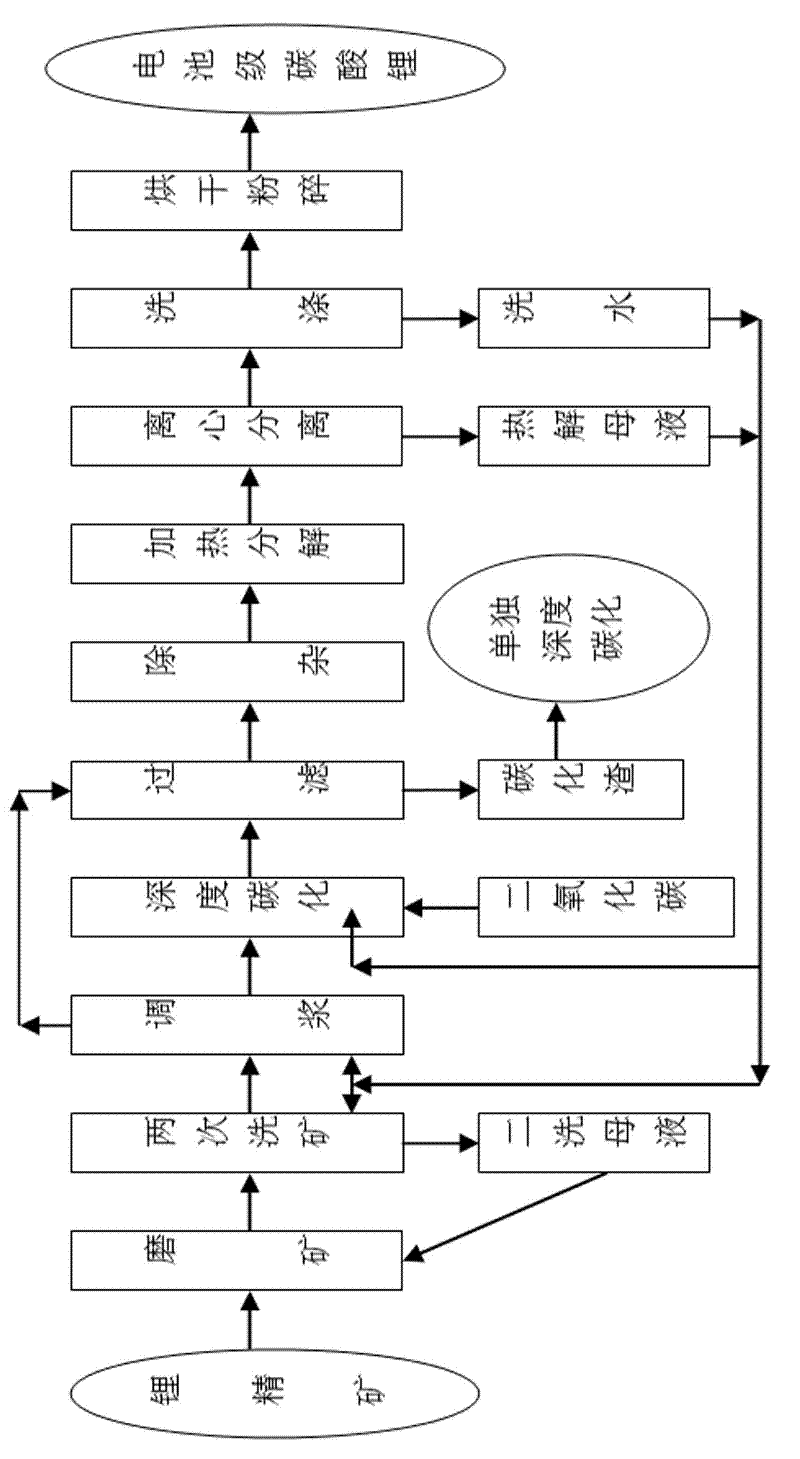Process for producing battery-grade lithium carbonate through processing carbonate type lithium concentrate by deep carbonation method
A technology of carbonate type and lithium concentrate, applied in the direction of lithium carbonate;/acid carbonate, etc., can solve the problems of high energy consumption, lithium slag, large amount of slag, etc.
- Summary
- Abstract
- Description
- Claims
- Application Information
AI Technical Summary
Problems solved by technology
Method used
Image
Examples
Embodiment 1
[0052] Table 3 Lithium concentrate composition analysis table
[0053]
[0054] Add lithium concentrate with a grade of 61.23% and industrial water into a ball mill for grinding. The liquid-solid ratio of the lithium concentrate slurry is 1.5:1. After grinding, the fineness of the concentrate reaches 91.2% under a 200-mesh sieve to obtain lithium concentrate slurry;
[0055] 2. Primary ore washing and secondary ore washing Put the ground lithium concentrate slurry into the enamel reaction kettle, stir while heating up, after heating up to 90°C, stir for 40 minutes and filter with a belt filter to obtain a primary Wash lithium concentrate and a wash mother liquor;
[0056] Put the first-time washing lithium concentrate into the enamel reaction kettle, adjust the liquid-solid ratio to 2:1 with industrial water, stir in the enamel reaction kettle for 40 minutes at 92°C, and then filter it with a belt filter to obtain the second washing Lithium concentrate and secondary washi...
Embodiment 2
[0073] Table 5 Lithium concentrate composition analysis table
[0074]
[0075] The lithium concentrate with a grade of 66.79% and the mother liquor of the second washing are added to a ball mill for grinding. The liquid-solid ratio of the lithium concentrate slurry is 1.3:1. mineral slurry;
[0076]2. Primary ore washing and secondary ore washing Put the ground lithium concentrate slurry into the enamel reaction kettle, stir and react for 40 minutes at 95°C, and then filter it with a belt filter to obtain the first-time washing lithium concentrate and a wash mother liquor;
[0077] Put the first-time washed lithium concentrate into the enamel reaction kettle, adjust the liquid-solid ratio to 2:1 with the pyrolysis mother liquor, stir in the enamel reaction kettle for 40 minutes at 90°C, and then filter it with a belt filter to obtain the second Wash the lithium concentrate and the second washing mother liquor; the weight percentage content of isolated lithium carbonate r...
Embodiment 3
[0094] 2. Primary ore washing and secondary ore washing Put the ground lithium concentrate slurry into the enamel reaction kettle, stir and react for 40 minutes at a temperature of 93°C, and then filter it with a belt filter to obtain the primary washing lithium concentrate and a wash mother liquor;
[0095] Put the first-time washed lithium concentrate into the enamel reaction kettle, adjust the liquid-solid ratio to 2:1 with the pyrolysis mother liquor, stir in the enamel reaction kettle for 40 minutes at 95°C, and then filter it with a belt filter to obtain the second Washing the lithium concentrate and the second washing mother liquor; the weight percentage content of isolated lithium carbonate reaches 86.8%;
[0096] 3. Sizing The liquid-solid ratio of the slurry is 3:1 to obtain the lithium concentrate slurry; the rest are the same as in Example 2;
[0097] 4. Deep carbonization Add the lithium concentrate slurry to the carbonization tower in excess of 3% of the calcula...
PUM
 Login to View More
Login to View More Abstract
Description
Claims
Application Information
 Login to View More
Login to View More - R&D
- Intellectual Property
- Life Sciences
- Materials
- Tech Scout
- Unparalleled Data Quality
- Higher Quality Content
- 60% Fewer Hallucinations
Browse by: Latest US Patents, China's latest patents, Technical Efficacy Thesaurus, Application Domain, Technology Topic, Popular Technical Reports.
© 2025 PatSnap. All rights reserved.Legal|Privacy policy|Modern Slavery Act Transparency Statement|Sitemap|About US| Contact US: help@patsnap.com



